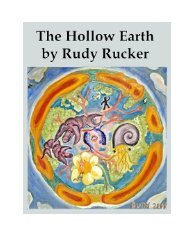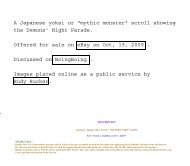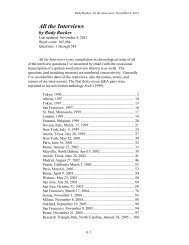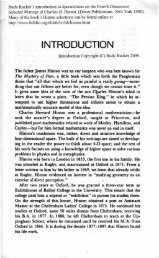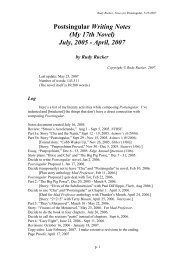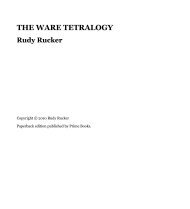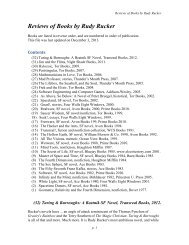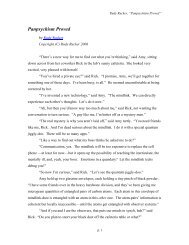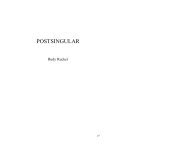Notes for the Lifebox, the Seashell, and the Soul - Rudy Rucker
Notes for the Lifebox, the Seashell, and the Soul - Rudy Rucker
Notes for the Lifebox, the Seashell, and the Soul - Rudy Rucker
You also want an ePaper? Increase the reach of your titles
YUMPU automatically turns print PDFs into web optimized ePapers that Google loves.
<strong>Notes</strong> <strong>for</strong> The <strong>Lifebox</strong>, <strong>the</strong> <strong>Seashell</strong>, <strong>and</strong> <strong>the</strong> <strong>Soul</strong>, by <strong>Rudy</strong> <strong>Rucker</strong><br />
Examples of alpha <strong>and</strong> b.<br />
x y Formula log-log u v <strong>for</strong>mula alpha b xshift<br />
y=1/x v = -u -1 0 0<br />
y = 1000/x v = 3-x -1 3 0<br />
y = x 2 v = 2 * u 2 0 0<br />
y = 10 x v = 10 u (need double<br />
0<br />
log paper)<br />
y = K/square v = log(K) - 0.5*u -0.5 log(K) 0<br />
root(x)<br />
y = y 0 (x) alpha v =<br />
alpha log(y 0 ) xshift<br />
log(y 0 )+alpha*u<br />
I wrote some examples of power laws on a piece of paper <strong>and</strong> lost <strong>the</strong>m, so lets try<br />
again.<br />
x axis y axis Pairs... Formula<br />
Size of<br />
advance<br />
10 7 , 1 10 6 , 10 10 5 , 10 2 10 2 , 10 5 v = 7-u;<br />
y = 10 7 /x<br />
Number of<br />
links<br />
Ordinal<br />
rank of<br />
word<br />
popularity<br />
Number of<br />
writers<br />
getting this<br />
advance<br />
Number of<br />
websites of<br />
this size<br />
Probability<br />
that a word<br />
is this<br />
word<br />
1, 0.5 2, 0.5<br />
(7) The rich get richer algorithm can account <strong>for</strong> power law clustering, it comes out<br />
with an exponent of -3. Two key steps (a) growing network with new nodes arriving <strong>for</strong>ever<br />
<strong>and</strong> (b) new nodes <strong>for</strong>m links with existing nodes with probability proportional to <strong>the</strong> number<br />
of links <strong>the</strong> existing nodes have. I read his Science paper on this too. This is essentially <strong>the</strong><br />
only result in his whole book.<br />
(8) In some networks one node wins <strong>and</strong> <strong>the</strong>y become stars.<br />
(9) Scale free networks are vulnerable in that if <strong>the</strong> highly linked hub nodes are<br />
knocked out <strong>the</strong> network breaks into pieces.<br />
(10) In a scale free network a virus can spread more easily because when <strong>the</strong> viruses<br />
get to hubs <strong>the</strong>y radiate out a lot.<br />
(11) Can <strong>the</strong> internet become self aware? Don’t know.<br />
(12) The Web actually breaks into pieces, given that links are directed. Central Core<br />
is mutually linked. In continent has links into Central Core, but you can’t get back to it.<br />
OUT continent has links from Central Core but no links back to Central Core. Isl<strong>and</strong>s have<br />
mutual links but don’t like back to core. Tubes run from IN to OUT.<br />
(13) Can make a network <strong>for</strong> <strong>the</strong> many biomolecules in a cell, saying that two are<br />
linked if <strong>the</strong>y participate in a reaction. Seems to be three degrees of separation typical in this<br />
small world network. Also seems to have a scale free topology.<br />
(14) If nodes are fat cats <strong>and</strong> a link is being on <strong>the</strong> board of a corporation we get a<br />
scale free network.<br />
p. 108



